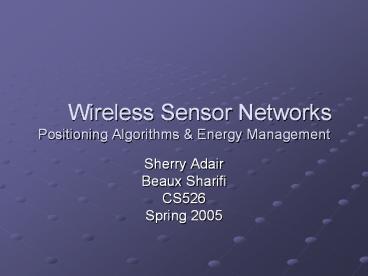Wireless Sensor Networks Positioning Algorithms - PowerPoint PPT Presentation
1 / 32
Title:
Wireless Sensor Networks Positioning Algorithms
Description:
Wireless Sensor Networks Positioning Algorithms & Energy Management Sherry Adair Beaux Sharifi CS526 Spring 2005 Agenda Motivation Positioning Algorithms Energy ... – PowerPoint PPT presentation
Number of Views:152
Avg rating:3.0/5.0
Title: Wireless Sensor Networks Positioning Algorithms
1
Wireless Sensor NetworksPositioning
Algorithms Energy Management
- Sherry Adair
- Beaux Sharifi
- CS526
- Spring 2005
2
Agenda
- Motivation
- Positioning Algorithms
- Energy Management
- References
3
Example Applications
4
Example Applications (cont)
UC Berkeley Biology Research
5
Research Focus
- Positioning Algorithms
- Energy Management
- Positioning Algorithms are distributed heuristic
algorithms used to determine the local or global
coordinate positions of nodes in an ad-hoc
wireless sensor network. - Most applications implicitly require positioning
information - Most research topics are focused on methods for
saving energy
6
Positioning Agenda
- Background
- 3 Different Algorithms
- Simulation Results
- Conclusion
7
Positioning Background
- 2D Trilateration
- 3D Trilateration
a
b
b
c
d
a
c
8
Positioning Background (cont)
- Two Major Difficulties to Positioning
- Sparse Anchor Node Problem
- Range Error Problem
9
Positioning Algorithms
- ABC Assumption Based Coordinate Savarese,
Rabaey, Beutel, 2001 - TERRAIN - Triangulation via Extended Range and
Redundant Association of Intermediate
Nodes Savarese, 2002 - Hop-TERRAIN Savarese, 2002
- Two-Phase Savarese, 2002
- First Phase Hop-TERRAIN
- Second Phase Refinement
10
TERRAIN Algorithm
ABC Algorithm n0 (0,0) n1 (r01, 0) n2 (r012
r022 r122) , r022 x22 )
2
(6,6)
(3,5)
2r01
3
(1,3)
Anchor Node Distance
GLOBAL POSITION GLOBAL POSITION
(3,2)
(5,2)
1
sqrt(62 62)
8.5
1
(0,0)
(5,1)
2
4.3
(3,0)
3
1.2
(18, 24)
11
Hop-TERRAIN Algorithm
- Binary nature provides following benefits
- No compounding of errors at each hop
- Provides consistent results
- Scales to much larger networks
2
3
Anchor Node Distance
GLOBAL POSITION GLOBAL POSITION
1
1
3 Hop Metric
6
4
2
3
2
(18, 24)
12
Two-Phase Refinement Algorithm
- First Phase Hop-TERRAIN
- Detects Edge Independence (for poor topologies)
- Second Phase Refinement
- Iterative improvement of positions via ranges
until position converges - Uses Confidence Metrics (for convergence)
13
Simulation ResultsTERRAIN vs. Hop-TERRAIN
Range Error Sensitivity of Hop-TERRAIN and
TERRAIN (nodes 40, anchors 4, range 10,
grid 30x30)
14
Simulation Results (cont)Hop-TERRAIN vs.
Refinement
Average Position Error After Refinement (5 Range
Errors)
Average Position Error After Hop-TERRAIN (5
Range Errors)
15
Simulation Results (cont)Hop-TERRAIN vs.
Refinement
Range Error Sensitivity between Hop-TERRAIN and
Refinement (10 Anchors, 12 Nodes Connectivity)
16
Positioning Conclusion
Algorithm Sparse Anchor Problem Range Error Problem
TERRAIN
Hop-TERRAIN
Two-Phase
17
Future Positioning Research
- Total Least Squares Algorithm
- Hop-Refinement
18
Energy Agenda
- Importance of Energy Management
- Sources of Wasted Energy
- Methods of Reducing Energy Consumption
- Future Research
- Conclusions
19
Importance of Energy Management
- Thousands of motes
- Not feasible to access them because of location,
or quantity - Reliability of application depends on motes
continuing to operate - Required to operate for many years
20
Source of Wasted Energy
- Transmissions
- Collisions
- Overhearing
- Control packet overhead
- Idle listening
- Lossy links
21
Methods of Reducing Energy Consumption
- Algorithms designed with power consumption in
mind - Special MAC protocols (S-MAC, B-MAC)
- Active/Sleep periods
- Decreasing the sensing coverage area
- Data Reduction
- Shorter, more reliable links
- Scavenging Power from solar, vibration using
custom IC
22
Special MAC Protocols
- Needed to focus on energy management
- Based on 802.11 protocol
- Use active/sleep schedule
- Collision Avoidance
- Increase latency
- Reconfigure network based on current load
- (B-MAC)
23
Example of Energy Saved by Sleeping
- System Components
- StrongArm SA-1110 microprocessor
- Sensor
- Radio
24
Mica2 sleep savings
Full operation of the sensor requires about 15ma
of current AA batteries supply 1800 ma which
would last about 120 hours or 5 days
25
Shorter, more reliable links
26
Energy Scavenging
27
Energy Scavenging (cont)
28
Energy Scavenging
PicoRadio Meso-scale radio
29
Moores Law
- Capabilities increasing
- Costs staying the same
- Power consumption staying the same
- Reduced power consumption for special purpose
nodes
30
Future Research
- Renewable sources of energy
- MAC protocols designed especially for WSN
- Custom low power ICs
31
Energy Conclusions
- Much energy is spent in the communication task of
the mote, with almost as much energy required to
listen as to send - Special MAC protocols are required to address the
special needs of WSN such as conserving power and
adjusting to the changing network topology - Active/sleep schedule is a common method used to
conserve energy. Tradeoff is latency in packet
delivery - Possibility of extending the lifetime of motes
using renewable energy sources such as solar and
vibration
32
References
- http//bwrc.eecs.berkeley.edu/People/Faculty/jan/p
resentations/AmbientIntelligence.pdf - Jason Hill, Mike Horton, Ralph Kling, Lakshman
Krishnamurthy. The Platforms Enabling Wireless
Sensor Networks. Communications of the ACM June
2004/ Vol47. No. 6. p 41-46. - C. Savarese, Robust Positioning Algorithms for
Distributed Ad-Hoc Wireless Sensor Networks,
Masters Thesis, 2002. - C. Savarese, J. Rabaey, and J. Beutel,
Locationing in Distributed Ad-hoc Wireless
Sensor Networks, in IEEE International
Conference on Acoustics, Speech, and Signal
Processing (ICASSP), pages 2037-2040, Salt Lake
City, UT, May 2001 - Eugene Shih, Seong-Hwan Cho, Nathan Ickes, Rex
Min, Amit Sinha, Alice Wang, and Anantha
Chandraskasan. Physical Layer Driven Protocol
and Algorithm Design for Energy-Efficient
Wireless Sensor Networks.































